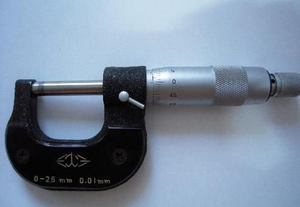
Thread Micrometer Inspection Requirements and Methods - Inspection and Audit Services for Factory Verification
To ensure the product quality of the thread micrometer, during the factory inspection, shipment inspection and product certification processes, a comprehensive inspection of the products is required in accordance with the following standards.
I. Type and Basic Parameter Certification
During the inspection and type certification process, it is necessary to first verify whether the basic configuration and key parameters of the product comply with the specifications.
Type confirmation: The product should be clearly defined as either rotary type or direct entry type. The structural schematic diagrams (see Figures 1 and 2) serve as the basic reference during the factory inspection. Additionally, it is necessary to confirm that the probe combination is V-shaped/conical (Figure 3) or V-shaped/blade-shaped (Figure 4).
Parameter verification: The inspector needs to check the following key parameters to ensure they are consistent with the specification document:
Measurement range: Must conform to the grading specified by the standard (such as 0-25mm, 25-50mm, etc.).
Pitch of the micrometer screw: It should be 0.5mm or 1mm.
Probe parameters: They must comply with the requirements of Table 1, which serves as the basis for verifying their measurement capabilities.
II. Core Items and Requirements for Inspection
Product quality inspection should cover the following key items, which are mandatory for inspection in the process.
Appearance inspection
The surface of the product must not have any defects such as cracks, scratches, rust, burrs, etc. that may affect its usability.
The electroplating or coating must not have any peeling or obvious color unevenness.
Material Certification
Scales frame: Must be made of steel, malleable cast iron or materials of equivalent performance.
Micrometer screw and probe: They must be made of alloy tool steel, stainless steel or materials of comparable performance. During the factory inspection, the material certificates should be verified.
Inspection of probe quality
The deviation of the tooth profile angle of the V-shaped and conical probes, as well as the symmetry tolerance of the measuring surface, must comply with the provisions of Table 2. This is the key to the accuracy certification and requires professional inspection using a universal tool microscope or a profilometer.
Rigidity test of the ruler frame
Under the action of an axial force of 10N, the deformation of the slide frame shall not exceed the allowable values specified in Table 3. This item is used to verify and certify the structural stability of the product.
Interaction test
Axial runout: For rotary type, it should not exceed 0.01mm; for direct entry type, it should not exceed 0.02mm.
Radial oscillation: The clearance between the smooth cylindrical part of the micrometer screw and the shaft sleeve should not exceed 0.01mm for the radial oscillation value. During inspection, a preliminary judgment can be made by hand, and if necessary, measurement with an instrument should be conducted.
Force measurement device certification
The product must be equipped with a force-measuring device, and the force measurement range should be between 5N and 10N, with a variation of no more than 2N. It needs to be inspected and certified using a force gauge.
Verification of the effectiveness of the locking device
The locking device of the rotating thread micrometer should not cause a change in the distance between the two measuring surfaces greater than 2.0 μm when it is locked.
Measurement surface performance certification
Hardness: The hardness of the measuring surface of the alloy tool steel should be ≥ 740HV, and that of the stainless steel should be ≥ 552HV. During the inspection process, the test can be conducted on the non-working surface of the probe.
Surface roughness: The Ra value of the measuring surface should not exceed 0.4 μm.
Proofreading gauge inspection and certification
Products with a measurement limit greater than 25mm must be equipped with calibration gauges. During inspection, it is necessary to confirm the following:
Its nominal size and deviation comply with the provisions of Table 4.
The tooth profile angle deviation shall not exceed ±4'.
Hardness ≥ 760HV1, surface roughness Ra ≤ 0.16μm. It is recommended to use the three-point method for precise inspection and certification.
Comprehensive Accuracy Certification
Indication error: By replacing the flat/spherical probe and conducting tests at multiple points throughout the entire range using standard blocks, the maximum allowable error must comply with the provisions of Table 3. This is a core certification item for the product's accuracy level.
The influence of the probe position on the indication error: By changing the position of the probe and conducting 8 measurements, the difference between the maximum and minimum values of the results should comply with the standard. This test verified the interchangeability and manufacturing accuracy of the probe.
Coaxiality inspection
Use a dedicated measuring rod to check the coaxiality of the two probe mounting holes, ensuring that the micrometer screw can rotate freely.
III. Marking, Packaging and Document Certification
At the end of the inspection process, final certification of product markings and accompanying documents is required.
Product marking: The body of the thread micrometer must clearly display the manufacturer/brand, measurement range, graduation value and product serial number.
Packaging and Marking: The packaging box should indicate the manufacturer's information, product name and measurement range. The product needs to be treated for rust prevention, and the packaging should be reliable to ensure no damage during transportation. This item is an important basis for judging the packaging process during the inspection.
Document Certification: Each set of products must be accompanied by the "Product Inspection Certificate" and the "User Manual". The certificate must clearly indicate the standard number, product serial number and manufacturing date, serving as the final proof that the product has passed the factory inspection and certification.
分享这个商品

Thread Micrometer Inspection Requirements and Methods - Inspection and
The thread micrometer is a precision instrument based on the principle of a screw pair, specifically designed for measuring the pitch diameter of threads.
